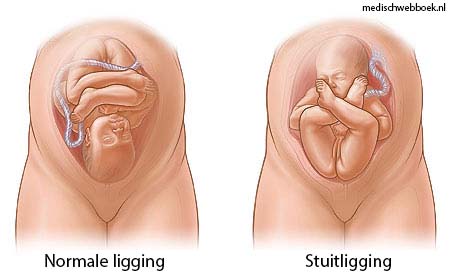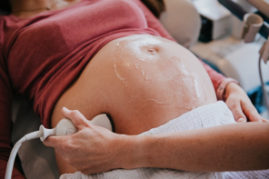
Breech position = Stuitligging

In the picture above, the picture on the left shows a normal position, whereas the one on the right shows the breech position.
During your pregnancy, your child may occasionally lie in the breech position. This means that your child is with his bottom down and his head up. This is normal. Children move a lot in the womb and adopt different positions during pregnancy.
At the end of the pregnancy there is less space in the womb. Your baby will still keep moving but turning and changing position will be more difficult.
Roughly 3% of children in the Netherlands are still in breech position at term (36-40 weeks). At this point, you will be faced with various choices. Do you want to turn your baby via external cephalic version (ECV)? What if this fails? And what do you think about a breech birth? Would you like to opt for a caesarean section?
If your child is in the breech position you will be given the choice to have an ECV. This is a manual procedure that intends to turn your child in the womb through pressure on the abdomen. The buttocks of your child are taken with one hand and the head with the other. By applying pressure in this way, your child makes a roll and comes to lie with his head down. This would allow for a better vaginal delivery.
Advice
As midwives, we always advise you to consider an ECV. When you manage to turn your baby, you reduce the risks during childbirth. A breech delivery or caesarean section carries more risks than a delivery in the head position.
Chances of success
Sometimes turning your child doesn’t work. Then your baby’s position is unfavorable or there is too much resistance. If there is too much resistance, the turning will not be forced.
In your first pregnancy, turning your baby is less easy compared to next pregnancies. A version is successful (on average) in 40% of cases with a first child and 50% of cases with a second child or more.
Complications
During an external version, complications are very rare.
Sometimes your child’s heart rate can slow or speed up temporarily. This almost always recovers within ten minutes. For this reason, your child’s heart rate is monitored before and after spins.
There is also a very small chance that labor will start or your membranes will rupture due to twisting, but the chance of this is just as high as the chance that this will happen spontaneously.
Alternatively, you may want to use acupuncture to try to turn the baby. Or you could consider this if you don’t want to do a version, or in case that failed. This treatment stimulates the baby to move more and to turn over.
The effectiveness of this treatment, however, has not been sufficiently proven.
Different positions give more space in your pelvis. You can leverage this during childbirth. If there is a breech position, you can also create space by doing exercises, so that the baby may take a different position.
These positions are taken from Spinning Babies. Spinning Babies’ techniques are aimed at balancing and aligning your body, as well as creating space for your baby to turn more easily when in breech.
Moxatherapy in combination with Spinning Babies positions can complement each other.
Would you like to learn these Spinning Babies techniques? Please contact Fysiotherapie Kennis.
If your baby is in the breech position, you can choose whether you want to give birth vaginally or whether you want to have a caesarean section.
This is often a difficult decision because both choices have drawbacks. For this reason, as midwives, we always first ask you to consider a version to attempt to turn the baby. If successful, the latter would allow for a safer vaginal delivery.
Risks
Children in the breech position who are born by caesarean section often have fewer problems during and after delivery than children in the breech position who are born vaginally.
However, research shows that after two years there is no difference in development and health between children who are born with caesarean section and children who are born vaginally. The difference during and after birth also disappeared after 2 years.
With a caesarean section the mother faces more risks of complications compared to a vaginal delivery.
There are also more risks for mother and child after a caesarean section during a subsequent delivery than after a vaginal delivery.
Breech delivery
You will be closely monitored during a breech delivery. Your child’s heart rate is registered with a heart film. In addition, the strength of your contractions is closely monitored and the speed of dilation must be good.
If the delivery is not optimal, this increases the risk of complications. For this reason, it may then be decided to perform a caesarean section.
Risks during a breech delivery are:
- The chance of admission to the incubator ward is slightly more common.
- The chance that your child will be born with a lower Apgar score is slightly higher.
- There is a greater risk of a nerve or muscle strain in your child’s neck or shoulder.
- The chance of a caesarean section is higher.
Cesarean section
When choosing a caesarean section, the time of the birth of your child is planned. If contractions commence earlier, a caesarean section will be performed at that time.
Risks during a caesarean section are:
- A higher chance of an infection with the mother.
- Your child is more likely to have an infection.
- The recovery time for the mother after a caesarean section is longer than after a vaginal delivery.
- There is a higher chance of excessive blood loss.
- There is more chance of bladder and bowel problems.
- There is a greater chance of complications during a subsequent delivery.
- This is due to the scar in the uterus. Because of this scar, there is a higher chance of the placenta growing incorrectly, excessive blood loss and tearing of the uterus.
- This in turn will increase the risks during the birth of a next child.
Lying in the breech position can affect the hip development of the child. Your child has a slightly higher chance of developing hip dysplasia. For this reason, it is recommended to make an ultrasound of the hips of your child 3 months after birth. This is arranged through the consultation office.
Pregnancy
Contact

Would you like to register or do you have a question?
Contact us →
News
Move
New location As of April 1, we will move to our new location near Emiclaer, ‘Het masker 208/210’, is under lees meer…
Dutch midwifery system
In Holland we are unique! For some women it is different, another system than in their home country. This film lees meer…
English website online
The English translation of our website is complete and now available! We welcome your feedback in case of inconsistencies, mistakes, lees meer…
 Verloskundigen Amersfoort is gewaardeerd op ZorgkaartNederland.Bekijk alle waarderingen of plaats een waardering
Verloskundigen Amersfoort is gewaardeerd op ZorgkaartNederland.Bekijk alle waarderingen of plaats een waardering